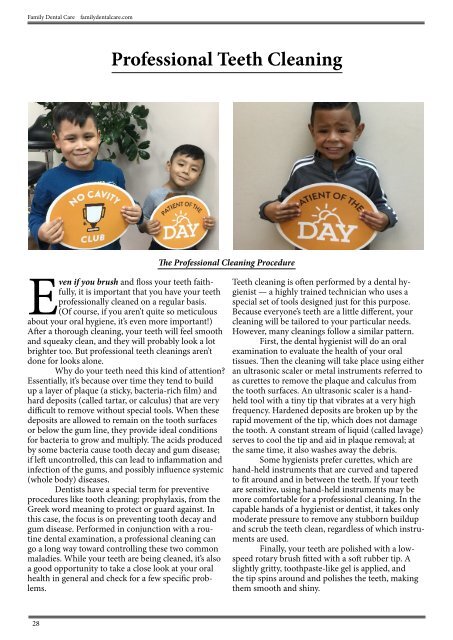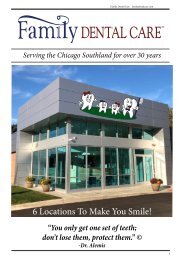Family Dental Care™ Magazine (2021 Edition)
2021 Edition from Family Dental Care™ in Chicago's Southland and NW Indiana
2021 Edition from Family Dental Care™ in Chicago's Southland and NW Indiana
You also want an ePaper? Increase the reach of your titles
YUMPU automatically turns print PDFs into web optimized ePapers that Google loves.
<strong>Family</strong> <strong>Dental</strong> Care familydentalcare.com <strong>Family</strong> <strong>Dental</strong> Care familydentalcare.com<br />
Professional Teeth Cleaning<br />
Hygienists<br />
Teeth Cleanings<br />
Cheryl Keller<br />
R.D.H.<br />
Sandra R. Mendoza<br />
R.D.H.<br />
Jennifer Sanders<br />
R.D.H.<br />
The Professional Cleaning Procedure<br />
Even if you brush and floss your teeth faithfully,<br />
it is important that you have your teeth<br />
professionally cleaned on a regular basis.<br />
(Of course, if you aren’t quite so meticulous<br />
about your oral hygiene, it’s even more important!)<br />
After a thorough cleaning, your teeth will feel smooth<br />
and squeaky clean, and they will probably look a lot<br />
brighter too. But professional teeth cleanings aren’t<br />
done for looks alone.<br />
Why do your teeth need this kind of attention?<br />
Essentially, it’s because over time they tend to build<br />
up a layer of plaque (a sticky, bacteria-rich film) and<br />
hard deposits (called tartar, or calculus) that are very<br />
difficult to remove without special tools. When these<br />
deposits are allowed to remain on the tooth surfaces<br />
or below the gum line, they provide ideal conditions<br />
for bacteria to grow and multiply. The acids produced<br />
by some bacteria cause tooth decay and gum disease;<br />
if left uncontrolled, this can lead to inflammation and<br />
infection of the gums, and possibly influence systemic<br />
(whole body) diseases.<br />
Dentists have a special term for preventive<br />
procedures like tooth cleaning: prophylaxis, from the<br />
Greek word meaning to protect or guard against. In<br />
this case, the focus is on preventing tooth decay and<br />
gum disease. Performed in conjunction with a routine<br />
dental examination, a professional cleaning can<br />
go a long way toward controlling these two common<br />
maladies. While your teeth are being cleaned, it’s also<br />
a good opportunity to take a close look at your oral<br />
health in general and check for a few specific problems.<br />
Teeth cleaning is often performed by a dental hygienist<br />
— a highly trained technician who uses a<br />
special set of tools designed just for this purpose.<br />
Because everyone’s teeth are a little different, your<br />
cleaning will be tailored to your particular needs.<br />
However, many cleanings follow a similar pattern.<br />
First, the dental hygienist will do an oral<br />
examination to evaluate the health of your oral<br />
tissues. Then the cleaning will take place using either<br />
an ultrasonic scaler or metal instruments referred to<br />
as curettes to remove the plaque and calculus from<br />
the tooth surfaces. An ultrasonic scaler is a handheld<br />
tool with a tiny tip that vibrates at a very high<br />
frequency. Hardened deposits are broken up by the<br />
rapid movement of the tip, which does not damage<br />
the tooth. A constant stream of liquid (called lavage)<br />
serves to cool the tip and aid in plaque removal; at<br />
the same time, it also washes away the debris.<br />
Some hygienists prefer curettes, which are<br />
hand-held instruments that are curved and tapered<br />
to fit around and in between the teeth. If your teeth<br />
are sensitive, using hand-held instruments may be<br />
more comfortable for a professional cleaning. In the<br />
capable hands of a hygienist or dentist, it takes only<br />
moderate pressure to remove any stubborn buildup<br />
and scrub the teeth clean, regardless of which instruments<br />
are used.<br />
Finally, your teeth are polished with a lowspeed<br />
rotary brush fitted with a soft rubber tip. A<br />
slightly gritty, toothpaste-like gel is applied, and<br />
the tip spins around and polishes the teeth, making<br />
them smooth and shiny.<br />
Iyad Omar<br />
R.D.H.<br />
Magdalena Lepacek<br />
R.D.H.<br />
Maria Kuruklis<br />
R.D.H.<br />
Marissa Gora<br />
R.D.H.<br />
Dhara Patel<br />
R.D.H.<br />
Diana Mondragon<br />
R.D.H.<br />
Marissa Lira<br />
R.D.H.<br />
28 29




